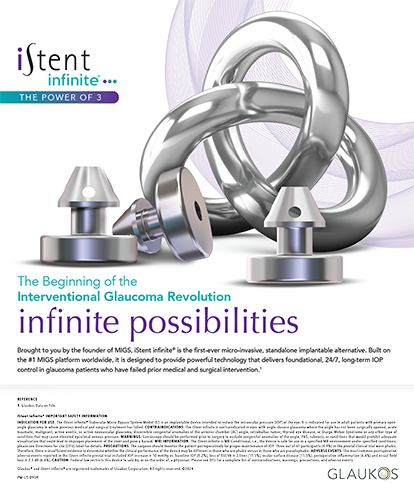
Risk Factors for the Development of Cataract in Children With Uveitis
Blum-Hareuveni T, Seguin-Greenstein S, Kramer M, et al1
Blum-Hareuveni and colleagues investigated risk factors for cataract formation in children with uveitis. The retrospective cohort study included 247 eyes of 140 children at Moorfields Eye Hospital in London and Schneider Children’s Medical Center of Israel/Rabin Medical Center. The researchers collected data from 2000 to 2014, and they excluded patients with fewer than 6 months of follow-up or those who had cataracts from their calculation of the incidence of cataract formation.
Of the 140 patients, 59% were female, and their average age was 10.3 ±0.4 years. Mean follow-up was 51.6 ±3.4 months (range, 6–261 months). The prevalence of cataracts in this study was 44.2%. The highest prevalence of cataracts occurred in patients with panuveitis (77.1%), followed by those with chronic anterior uveitis (48.3%), intermediate uveitis (48.0%), and posterior uveitis (16.7%). At presentation, 164 eyes of 94 patients were phakic without cataract. The mean age of this group was 11.2 ±0.4 years (range, 3–18 years). Sixty-one eyes (37.2%) developed a cataract during the study, with a median time to development of 96 months (95% confidence interval, 56.9–135.1 months) and an incidence of 0.09 cases per eye-year.
STUDY IN BRIEF
A retrospective cohort study investigated risk factors for cataract formation in children with uveitis. The researchers found that cataract formation was common and could occur over several years in these patients.
WHY IT MATTERS
Cataract formation is a common cause of vision problems in patients with uveitis, particularly children. Because vision loss from cataracts in pediatric patients can be complicated by the development of amblyopia, it is important to identify populations at risk. This study evaluated children with uveitis from a broad spectrum of etiologies, as opposed to previous reports that looked primarily at uveitis related to juvenile idiopathic arthritis. The researchers found that markers of inflammation—in particular the degree of inflammation—were risk factors for cataract development. Furthermore, the investigators concluded that poor disease control resulting in refractory disease and frequent relapses overshadowed the effects of topical and systemic steroids in the development of cataracts, and they suggested more aggressive attempts at disease control with these agents to help minimize cataract development in children with uveitis.
The investigators found that the type of uveitis, particularly panuveitis, was a risk factor for cataract formation (P = .02). Furthermore, after adjusting for all factors, the number of flare-ups per year (hazard ratio [HR], 3.06; P < .001), the presence of posterior synechiae at presentation (HR, 2.85; P = .001), local corticosteroid injection (HR, 2.38; P = .02), and the development of cystoid macular edema (CME; HR, 2.87; P = .004) were significant.
The researchers reported that cataract formation was common and could occur over several years in pediatric patients with uveitis. The investigators suggested that disease control with the minimal amount of medication possible should be a primary goal in this population.
DISCUSSION
Cataract formation is a common cause of vision problems in patients with uveitis, particularly children. Because vision loss from cataracts in pediatric patients can be complicated by the development of amblyopia, it is important to identify populations at risk.
Blum-Hareuveni and colleagues evaluated children with uveitis from a broad spectrum of etiologies, as opposed to previous reports that looked primarily at uveitis related to juvenile idiopathic arthritis (JIA). The prevalence of cataracts seen in this study reflected that found in other studies (20–64%).2-5 The incidence reported by Blum-Hareuveni et al (0.09 cataracts per eye-year) was higher than that seen in other studies of JIA patients (0.04 per eye-year).6 The investigators defined a cataract as the presence of a lens opacity that corresponded to consistent visual deterioration. This definition was stricter than in studies that used surgical extraction as a diagnostic criterion7,8 and may explain the higher rates found by Blum-Hareuveni et al.
Importantly, the group found that markers of inflammation (in particular the degree of inflammation) such as the presence of CME, posterior synechiae, and number of uveitis flares were risk factors for cataract development. Furthermore, they did not detect a significant difference in cataract formation with treatment by local or systemic steroid injection, whereas other studies have found treatment to be a risk factor for JIA-related uveitis.6,8,9 Blum-Hareuveni et al concluded that poor disease control resulting in refractory disease and frequent relapses overshadowed the effects of topical and systemic steroids in the development of cataracts, and they suggested more aggressive attempts at disease control with topical and systemic steroids to help minimize cataract development in children with uveitis.
Cataract Surgery in Uveitis: a Multicenter Database Study
Chu CJ, Dick AD, Johnston RL, et al; for the UK Pseudophakic Macular Edema Study Group10
Chu and colleagues sought to estimate the visual gains and quantify the risks associated with cataract extraction in patients who have uveitis compared to those without the condition. Before this study, there were few reliable sources of prognostic information to guide patient expectations or surgical planning. This retrospective chart review included small-incision phacoemulsification cases performed between January 2010 and December 2014 in eight ophthalmology departments within the UK National Health Service using a shared electronic health records system and standardized recording practices.
Overall, the investigators collected data on 1,173 uveitic eyes of all etiologies and 95,573 eyes without the condition. The mean age at the time of surgery was 74.36 years for nonuveitic cases and 66.43 years for uveitic cases (P < .0001). Preoperative visual acuity was worse for uveitic than nonuveitic eyes (0.87 vs 0.65 logMAR units, P < .0001), and there was no difference between groups in terms of the preoperative use of topical NSAIDS or the presence of an epiretinal membrane, amblyopia, or corneal pathology.
STUDY IN BRIEF
The UK Pseudophakic Macular Edema Study sought to estimate the visual gain and to quantify the risks associated with cataract extraction in patients who have uveitis compared with those without the condition.
WHY IT MATTERS
Cataracts are responsible for a significant portion of vision loss in patients with uveitis, and cataract extraction is widely viewed as more technically challenging in these eyes. Prior to this study, there were few reliable sources of prognostic information to guide patient expectations or surgical planning. This research provides a solid foundation for an approach to uveitic cataracts.
Intraoperative complications included a higher likelihood of requiring combined procedures among uveitic eyes; the majority were “other procedures” or iris manipulation (iris hooks, pupil rings, sphincterotomy, synecholysis). Additionally, uveitic eyes had a higher incidence of posterior capsular rupture (3.89% vs 5.88%, P = .0005). Assessments revealed poorer visual acuity among uveitic eyes for all three postoperative periods (4, 4–12, and 12–24 weeks) as well as slightly higher postoperative IOPs. Finally, there was a higher prevalence of postoperative macular edema in the uveitic group (3.33% vs 1.35%, P < .0001) when the investigators excluded diabetic eyes as well as an increased likelihood of postoperative steroid and topical NSAID use in the uveitic group.
DISCUSSION
Cataracts are responsible for a significant portion of vision loss in patients with uveitis, and cataract extraction is widely viewed as more technically challenging in these eyes. Although Chu and colleagues were unable to perform a subgroup analysis regarding the etiology of uveitis, this research provides a solid foundation for an approach to uveitic cataracts. Among the merits of this study compared with prior case reports are that its large-scale analysis produced more generalizable and reliable data using contemporaneous surgical techniques. The higher incidence of intraoperative iris manipulation in uveitic eyes is similar to that in earlier reports.11 Additionally, the study by Chu and colleagues revealed a higher incidence of posterior capsular compromise than previously reported.11
A similar proportion of eyes were able to achieve a postoperative visual acuity of 20/40 or better in this study as in an earlier report (69% within a 4- to 12-week postoperative interval vs 68%).12 If preoperative visual acuity can be taken as a surrogate for preoperative control of uveitis, the study by Chu and colleagues is in agreement with others showing that improved preoperative control of uveitis is associated with better visual outcomes.12 When combined with the growing body of literature, these findings may help to guide the timing of cataract extraction, surgical strategies, and patient selection.
1. Blum-Hareuveni T, Seguin-Greenstein S, Kramer M, et al. Risk factors for the development of cataract in children with uveitis. Am J Ophthalmol. 2017;177:139-143.
2. Sabri K, Saurenmann RK, Silverman ED, Levin AV. Course, complications, and outcome of juvenile arthritis-related uveitis. J AAPOS. 2008;12(6):539-545.
3. Rosenberg KD, Feuer WJ, Davis JL. Ocular complications of pediatric uveitis. Ophthalmology. 2004;111(12):2299-2306.
4. Tomkins-Netzer O, Talat L, Bar A, et al. Long-term clinical outcome and causes of vision loss in patients with uveitis. Ophthalmology. 2014;121(12):2387-2392.
5. Jones NP. The Manchester Uveitis Clinic: the first 3000 patients, 2: uveitis manifestations, complications, medical and surgical management. Ocul Immunol Inflamm. 2015;23(2):127-134.
6. Thorne JE, Woreta FA, Dunn JP, Jabs DA. Risk of cataract development among children with juvenile idiopathic arthritis-related uveitis treated with topical corticosteroids. Ophthalmology. 2010;117(7):1436-1441.
7. Edelsten C, Lee V, Bentley CR, et al. An evaluation of baseline risk factors predicting severity in juvenile idiopathic arthritis associated uveitis and other chronic anterior uveitis in early childhood. Br J Ophthalmol. 2002;86(1):51-56.
8. Sijssens KM, Rothova A, Van De Vijver DA, et al. Risk factors for the development of cataract requiring surgery in uveitis associated with juvenile idiopathic arthritis. Am J Ophthalmol. 2007;144(4):574-579.
9. Wolf MD, Lichter PR, Ragsdale CG. Prognostic factors in the uveitis of juvenile rheumatoid arthritis. Ophthalmology. 1987;94(10):1242-1248.
10. Chu CJ, Dick AD, Johnston RL, et al, for the UK Pseudophakic Macular Edema Study Group. Cataract surgery in uveitis: a multicentre database study. Br J Ophthalmol. 2017;1010:1132-1137.
11. Pålsson S, Andersson Grönlund M, Skiljic D, Zetterberg M. Phacoemulsification with primary implantation of an intraocular lens in patients with uveitis. Clin Ophthalmol. 2017;11:1549-1555.
12. Mehta S, Linton MM, Kempen JH. Outcomes of cataract surgery in patients with uveitis: a systematic review and meta-analysis. Am J Ophthalmol. 2014;158(4):676-692.e7.




